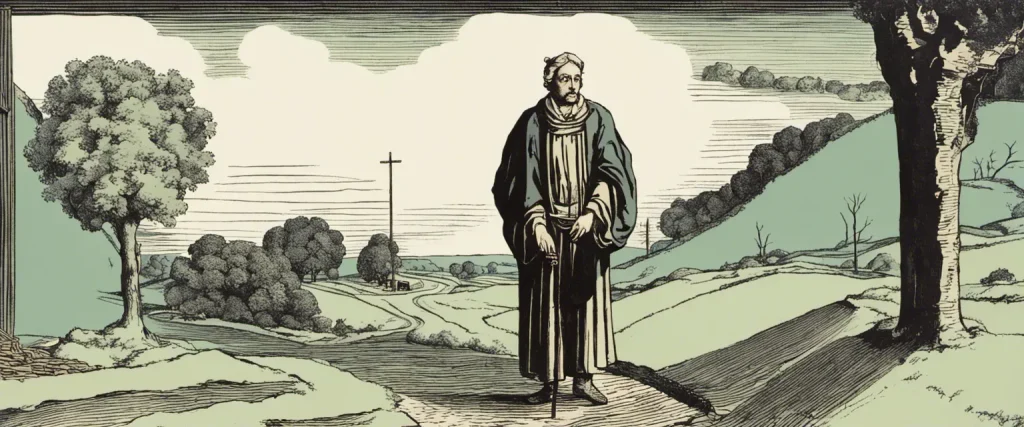In the timeless Spanish literary masterpiece, “The Life of Lazarillo de Tormes,” anonymous authorship conceals a reflective and satirical tale that delves into 16th-century Spanish society. This compelling first-person narrative narrates the adventures and misfortunes of a young boy named Lazarillo de Tormes, who embarks on an arduous journey to survive as a lowly servant. Through clever wit and a shrewd eye, the anonymous author vividly portrays the moral and social decay of his era, while delving into themes of deception, survival, and the indomitable spirit of the human condition. Although the author’s true identity remains a mystery, their poignant critique of their society endures as a captivating work of literature, urging readers to reimagine their perception of the world around them.
Chapter 1: Introduction to Lazarillo de Tormes
Chapter 1: Introduction to Lazarillo de Tormes of the book “The Life of Lazarillo de Tormes” by Anonymous, introduces the readers to the protagonist, Lazarillo, and sets the stage for his life story. The story is presented as a letter from Lazarillo to an unknown person, in which he narrates his life experiences.
Lazarillo starts by explaining his humble beginnings, as he was born in poverty. His father, Tomé González, works as a miller and his mother, Antona Pérez, is a merchant who sells a variety of items in the marketplace. However, due to his father’s excessive drinking and gambling, the family faces financial difficulties.
As Lazarillo grows up, he paints a vivid picture of his childhood in a small town. He describes the struggle he faces as his parents try to provide for him. His mother devises a plan to send him away to live with a blind man, who will teach him the trade of a town crier. However, Lazarillo soon realizes that the blind man is not as kind and generous as he initially appeared. Instead, he proves to be deceitful and manipulative, using Lazarillo for his own gains.
Throughout the chapter, the author emphasizes the theme of deception and the harsh realities of life for the lower class. Lazarillo’s experiences with the blind man serve as a microcosm of the hardships faced by those in poverty. This sets the stage for Lazarillo’s future encounters with various masters, each of whom will shape his understanding of the world and contribute to his own development.
Chapter 1 serves as an engaging introduction, giving readers a glimpse into the challenging and unpredictable life of Lazarillo de Tormes. It establishes the backdrop against which Lazarillo’s story unfolds, providing a foundation for the themes of survival, social class, and the struggle for a better life.
Chapter 2: Childhood and Early Life
Chapter 2: Childhood and Early Life of the book “The Life of Lazarillo de Tormes” by Anonymous provides insights into the challenging upbringing and early experiences of the protagonist, Lazarillo de Tormes.
Lazarillo begins his story by revealing that he was born in a small town near Salamanca, Spain, to poverty-stricken parents. His father was a miller, and his mother worked as a spinner to make ends meet. Unfortunately, life was tough, as his father lost his job and the family struggled to put food on the table. Eventually, they moved to the city of Salamanca in search of better opportunities.
In Salamanca, Lazarillo’s parents decide to find work outside the city and leave him in the care of a blind beggar known as “El Ciego.” Under El Ciego’s guardianship, Lazarillo learns how to navigate the streets of Salamanca and encounters the harsh realities of survival. El Ciego teaches him the art of begging and manipulates people’s compassion to get money.
However, El Ciego’s position as Lazarillo’s caretaker does not last long. Lazarillo soon discovers that the blind beggar has been deceiving him by secretly hoarding food and treating him poorly. Determined to escape his cruel existence, Lazarillo cleverly tricks El Ciego into falling into a river, leaving him behind.
After this event, Lazarillo is taken in by a kind and humble squire who offers him a new home and initiates him into service. Though initially relieved, Lazarillo soon realizes that the squire is no better than El Ciego. The squire’s dishonest ways and unwillingness to work force Lazarillo to face deception once again.
Chapter 2 presents a vivid picture of Lazarillo’s difficult childhood and foreshadows the struggles he will face throughout his life. These early experiences plant the seeds of survival and cunning within the young protagonist, shaping his future as a skilled and resourceful individual.
Chapter 3: The First Master
Chapter 3 of “The Life of Lazarillo de Tormes” begins with Lazarillo being assigned to work for a new master. This master happens to be a blind man, whom Lazarillo initially believes will be easier to deceive due to his lack of sight. However, he soon realizes that his new master is actually quite cunning and manipulative.
Lazarillo’s blind master is extremely resourceful and able to navigate the streets confidently, despite his disability. He pretends to be a beggar, complete with a stick and a cup for people to put money in. However, Lazarillo quickly discovers that his master is not as poor as he seems. In fact, he often receives gifts and money from people who believe he is genuinely destitute.
To Lazarillo’s surprise, he is only given meager portions of the food his master receives, and he often goes hungry. Lazarillo realizes that his master does this intentionally to keep him dependent and obedient. The blind man also does not trust Lazarillo and makes him keep the money he collects, always suspecting that he is being cheated.
One day, Lazarillo gets an opportunity to take advantage of his master. He discovers a way to steal some of the food his master receives, ensuring that he satisfies his hunger. However, he later realizes that his master had been aware of his actions all along and had intentionally baited him into stealing.
Chapter 3 of “The Life of Lazarillo de Tormes” highlights the theme of deception and manipulation. Despite being blind, Lazarillo’s master is able to cunningly control and manipulate his surroundings. Lazarillo, on the other hand, is initially fooled by his master’s appearance but quickly learns that appearances can be deceiving. This chapter sets the stage for the challenges Lazarillo will face as he continues his journey.
Chapter 4: The Blind Beggar

Chapter 4 of “The Life of Lazarillo de Tormes” by Anonymous, titled “The Blind Beggar,” continues the adventures of the protagonist, Lazarillo, as he seeks employment and tries to escape poverty. Lazarillo finds himself in a new town, looking for a job and a way to sustain himself. He comes across a blind beggar who appears to be helpless and unable to do much for himself. Feeling sorry for the man, Lazarillo offers the beggar assistance in exchange for some of the alms he receives.
Lazarillo quickly discovers that the blind beggar is not as helpless as he initially seemed. The beggar possesses clever tricks and strategies to exploit people’s sympathy and gain more money. Lazarillo learns from him how to fake a wound, use hidden crutches, and manipulate others emotionally. Although morally questionable, these techniques prove to be effective in increasing the beggar’s income.
As the days pass, Lazarillo becomes more skilled and observant, recognizing the beggar’s cunning ways and the manipulation tactics he employs to extract alms from others. He also learns that the beggar has a secret stash where he hides much of the money he receives, revealing his greed and dishonesty.
Despite being grateful to the blind beggar for teaching him survival skills, Lazarillo grows increasingly frustrated and wants to improve his own situation. He realizes that remaining dependent on the beggar’s lifestyle will only perpetuate his poverty and deceit. Therefore, Lazarillo decides to leave the blind beggar and seek better opportunities elsewhere, determined to find a more honorable way to make a living.
In Chapter 4, Lazarillo’s encounter with the blind beggar exposes him to the harsh realities of survival, greed, and manipulation. This experience marks a turning point in Lazarillo’s character, as he begins to question the morality of his choices and strive for a more honest and self-sufficient life.
Chapter 5: The Priest and His Trickery
Chapter 5 of The Life of Lazarillo de Tormes, written by Anonymous, titled “The Priest and His Trickery,” delves into the cunning and deceitful nature of a priest whom Lazarillo serves. Throughout the chapter, Lazarillo narrates the various ways in which the priest takes advantage of his position of authority and manipulates those around him to satisfy his own desires and needs.
The chapter begins with Lazarillo praising the priest for his extensive knowledge and intelligence, regarding him as someone who possesses great wisdom and understanding. However, Lazarillo soon learns that the priest’s true character is far from admirable. The priest uses tactics such as feigning illness to receive charity and exploiting others’ generosity to enhance his own wealth.
Lazarillo reveals that the priest’s trickery goes beyond mere financial gain. The priest seduces young women in the area, engaging in illicit affairs and flaunting his authority to avoid any repercussions. He cleverly covers up his actions by using his status as a clergyman and manipulating the perception of the townspeople.
Lazarillo himself becomes a victim of the priest’s deceit when he is tasked with guarding the priest’s secret lover, a woman who disguises herself as a male relative. Lazarillo faithfully obeys the priest’s demands, completely unaware of the priest’s true intentions, until he is ultimately exposed to the woman’s true identity and purpose.
In this chapter, the reader is presented with a stark portrayal of corruption within the Church, as the priest uses his position and authority for personal gain and engages in immorality without fear of consequences. Through Lazarillo’s narration, we witness the blatant manipulation and trickery of the priest, illustrating the perversion of power and trust in sixteenth-century Spanish society.
Chapter 6: The Squire and His Appetite
Chapter 6 of “The Life of Lazarillo de Tormes” by Anonymous, titled “The Squire and His Appetite,” follows the protagonist Lazarillo’s experience with his new master, a squire in the Spanish town of Toro.
Lazarillo starts by introducing his new master, who is a gluttonous and perpetually hungry man. The squire is constantly in search of food, and his insatiable appetite dominates his actions and thoughts. Lazarillo describes how they go from house to house, asking for leftovers or any food that people can spare.
One day, they are invited to a feast at a kind baker’s house. The squire seems overwhelmed by the sight of the food and cannot control his voracious appetite. As the squire eats, the baker’s wife scolds him for being so greedy, referring to him as a “gluttonous good-for-nothing.” The master, unfazed, only responds by saying he is a knight and therefore entitled to a large appetite.
After that incident, Lazarillo learns that his master often tricks people out of their food. On one occasion, the squire asks to borrow a knife for a moment and ends up stealing pieces of meat from a vendor’s stall. He devours the stolen meat, leaving Lazarillo feeling guilty for being part of such deceitful acts.
Throughout the chapter, Lazarillo represents himself as an observer rather than a participant in these gluttonous endeavors, expressing his disapproval for his master’s actions. It becomes evident that the squire’s constant hunger defines his character, highlighting the theme of deception and the struggle for survival in this cynical and challenging world.
In summary, Chapter 6 explores Lazarillo’s relationship with his hungry and morally dubious squire, who goes to great lengths to satisfy his insatiable appetite.
Chapter 7: The Friar and His Secrets
In Chapter 7 of “The Life of Lazarillo de Tormes,” written by an anonymous author, the titular character continues his journey with a new master, a friar. The chapter unveils the friar’s unscrupulous behavior, emphasizing the religious hypocrisy prevalent during the period.
Lazarillo narrates how the friar pretends to be a humble and devout servant of God, while secretly indulging in vices such as greed and gluttony. The friar deceives people by presenting himself as poor, fasting, and committed to a virtuous life. However, Lazarillo discovers that the friar cunningly ensures his own comfort and indulgence at the expense of others.
The friar uses his position to receive charitable donations from people, exploiting their generosity under the guise of needing support. He cleverly manipulates households into giving him the best quality foods, wine, and other luxurious items. Moreover, he maintains relationships with adulterous women, satisfying his carnal desires behind closed doors.
Lazarillo’s tone is one of resentment and disapproval as he witnesses these actions. He describes the friar’s manipulative tactics and reveals his hypocritical nature, highlighting the disparity between the friar’s public persona and his true character. It becomes clear that the friar’s religious lifestyle is merely a facade to gain personal benefits, reflecting the prevalent corruption within religious institutions during the time.
Chapter 7 serves as a critique of the hypocritical practices of certain religious figures, shedding light on the societal and moral decay within the church. Through Lazarillo’s account, the anonymous author exposes the dubious behavior of those who are expected to be morally upright, providing a critical commentary on the religious institutions of the time.

Chapter 8: The Nobleman and the Final Chapter
Chapter 8 of “The Life of Lazarillo de Tormes” introduces a new master for Lazarillo, a nobleman who promises to treat him well. However, Lazarillo soon discovers that the nobleman’s generosity is merely a facade. The nobleman’s true nature is revealed through a series of deceitful and manipulative actions.
Initially, Lazarillo is impressed by the grandeur of the nobleman’s house and his apparent wealth. However, he soon realizes that the nobleman’s lavish lifestyle is built on trickery and dishonesty. The nobleman presents himself as a man of honor, but in reality, he conspires with Lazarillo to deceive others and steal from them.
Lazarillo is instructed by his master to situate himself under a bridge, pretending to be blind and begging for alms. The nobleman, disguised as a blind man himself, would go to the bridge and engage in conversation with Lazarillo, pretending to be another beggar. They both play their roles convincingly and manage to deceive unsuspecting passersby who offer them money and other forms of charity.
This chapter reinforces the theme of deceit and the willingness of characters to exploit others’ misfortune for personal gain. The nobleman represents the hypocrisy and corruption prevalent in society during the time in which the book was written.
The final chapter of the book serves as a culmination of Lazarillo’s experiences with various masters and highlights his growing disillusionment with humanity. It reflects Lazarillo’s realization that survival in a cruel world often requires manipulation and deceit. The final scene sees Lazarillo talking to God, asking for forgiveness for his actions, and reflecting on the hardships he has endured. The conclusion leaves readers with a sense of moral ambiguity, questioning the virtues and vices of human nature.
After Reading
In conclusion, “The Life of Lazarillo de Tormes” is a satirical novella that provides an insightful portrayal of 16th-century Spanish society. Through the story of the young and cunning Lazarillo, the anonymous author exposes the deceit, corruption, and hypocrisy prevalent in the upper echelons of society. The book highlights the challenging circumstances faced by the lower classes and the power dynamics that shape their lives. With its dark humor and sharp social commentary, “The Life of Lazarillo de Tormes” remains a timeless work that forces readers to confront the realities of social inequality and human nature.
1. Pedro Paramo by Juan Rulfo: This haunting masterpiece of Latin American literature takes readers on a surreal journey through the ghostly town of Comala. Rulfo’s poetic prose and innovative storytelling technique paint a vivid picture of a town haunted by the memories and sins of its inhabitants. Exploring themes of love, death, and the search for identity, Pedro Paramo is a must-read for fans of magical realism and experimental literature.
2. War and Peace by Leo Tolstoy: Regarded as one of the greatest novels ever written, War and Peace is an epic tale set against the backdrop of Napoleonic wars. Tolstoy weaves together the lives of various characters, showcasing the impact of war on individuals and society as a whole. With its meticulous historical detail, profound philosophical insights, and rich character development, this novel offers a profound exploration of love, power, and the complexities of the human condition.
3. Little Women by Louisa May Alcott: A beloved classic, Little Women follows the lives of the March sisters as they navigate the challenges and joys of growing up in 19th-century America. Through the dreams, ambitions, and struggles of Meg, Jo, Beth, and Amy, Alcott offers a heartwarming portrayal of family, sisterhood, and female empowerment. This timeless coming-of-age story resonates with readers of all ages, highlighting the power of love, friendship, and the pursuit of personal dreams.
4. One Hundred Years of Solitude by Gabriel Garcia Marquez: Set in the fictional town of Macondo, this renowned novel tells the story of the Buendia family across six generations. Marquez’s lyrical prose and magical realism transport readers into a world of wonder and fantastical events, while also exploring themes of love, solitude, and the cyclical nature of history. One Hundred Years of Solitude is a captivating literary masterpiece that delves into the complexities of human existence and the fragility of memory.
5. To Kill a Mockingbird by Harper Lee: A classic in American literature, this Pulitzer Prize-winning novel tackles themes of racial injustice, morality, and the loss of innocence in the 1930s Deep South. Through the eyes of Scout Finch, a young girl growing up in a racially divided community, Harper Lee exposes the harsh realities of prejudice and discrimination. With its powerful storytelling and memorable characters, To Kill a Mockingbird remains a relevant and thought-provoking exploration of social issues and the enduring fight for justice.



